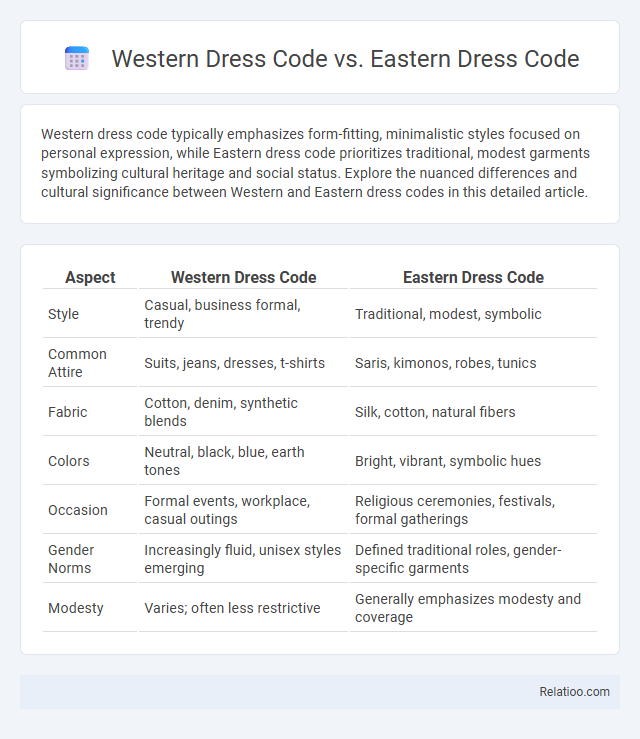Western dress code typically emphasizes form-fitting, minimalistic styles focused on personal expression, while Eastern dress code prioritizes traditional, modest garments symbolizing cultural heritage and social status. Explore the nuanced differences and cultural significance between Western and Eastern dress codes in this detailed article.
Table of Comparison
| Aspect | Western Dress Code | Eastern Dress Code |
|---|---|---|
| Style | Casual, business formal, trendy | Traditional, modest, symbolic |
| Common Attire | Suits, jeans, dresses, t-shirts | Saris, kimonos, robes, tunics |
| Fabric | Cotton, denim, synthetic blends | Silk, cotton, natural fibers |
| Colors | Neutral, black, blue, earth tones | Bright, vibrant, symbolic hues |
| Occasion | Formal events, workplace, casual outings | Religious ceremonies, festivals, formal gatherings |
| Gender Norms | Increasingly fluid, unisex styles emerging | Defined traditional roles, gender-specific garments |
| Modesty | Varies; often less restrictive | Generally emphasizes modesty and coverage |
Historical Evolution of Western and Eastern Dress Codes
Western dress codes evolved from ancient Greek and Roman attire, transitioning through medieval and Renaissance influences to modern Western fashion emphasizing tailored suits, dresses, and formal wear. Eastern dress codes reflect centuries-old traditions rooted in cultural, religious, and climate factors, such as the kimono in Japan, sarees in India, and hanbok in Korea, often preserving symbolic elements and ceremonial significance. The historical evolution of dress codes highlights contrasting values: Western styles prioritize individualism and practicality, while Eastern styles emphasize cultural identity and social harmony.
Key Elements of Western Fashion Styles
Western dress code emphasizes tailored fits, neutral colors, and minimalistic designs that prioritize comfort and professionalism for your daily wardrobe. Key elements include structured suits, clean lines, and versatile pieces like blazers, dress shirts, and tailored trousers that adapt to various social and business settings. This contrasts with Eastern dress codes, which often showcase intricate patterns, vibrant colors, and traditional fabrics reflecting cultural heritage.
Traditional Attire in Eastern Cultures
Traditional attire in Eastern cultures often emphasizes intricate designs, vibrant colors, and symbolic meanings, reflecting cultural heritage and social status. In contrast, Western dress codes typically prioritize functionality and simplicity, with formalwear such as suits and dresses following standardized patterns. Understanding these distinctions highlights how Eastern dress codes preserve identity through garments like saris, kimonos, and hanboks, while Western attire adapts to modern professional and social settings.
Cultural Symbolism in Dress Codes
Western dress code often emphasizes individuality and modernity, with styles reflecting professionalism and casual comfort, while Eastern dress codes tend to embody cultural heritage, tradition, and social status through intricate fabrics and symbolic designs. Dress codes across cultures serve as powerful tools of communication, conveying respect, identity, and societal roles beyond mere appearance. Understanding the cultural symbolism embedded in your attire can enhance cross-cultural appreciation and ensure respectful interaction in diverse environments.
Influence of Religion on Clothing Choices
Western dress codes often emphasize individual expression and secular fashion trends, whereas Eastern dress codes are deeply influenced by cultural and religious traditions, such as modesty in Islamic attire or Hindu ceremonial garments. Your clothing choices in Eastern societies may reflect spiritual values and community norms, showcasing respect for religious practices through specific fabrics, colors, or styles. Dress codes globally reveal how religion shapes attire, guiding what is considered appropriate and symbolizing deeper beliefs within diverse cultures.
Modern Adaptations and Fusion Styles
Modern adaptations of Western dress codes emphasize tailored suits, minimalistic designs, and casual business attire, reflecting a blend of professionalism and comfort. Eastern dress codes increasingly incorporate vibrant colors, intricate patterns, and traditional fabrics like silk, while integrating contemporary silhouettes for versatility. Fusion styles combine elements such as Western blazers with Eastern embroidery or pairing kurta tops with jeans, creating innovative fashion that bridges cultural heritage and global trends.
Dress Codes in Professional Settings: East vs. West
Western dress codes in professional settings emphasize tailored suits, neutral colors, and minimal accessories to project authority and professionalism. Eastern dress codes often incorporate traditional garments and cultural elements, balancing formality with respect for heritage, such as saris in India or business suits with subtle cultural accents in Japan. Both regions prioritize neatness and appropriateness, but cultural values shape the expression of professionalism through distinct attire standards.
Social Perceptions and Gender Norms
Western dress codes often emphasize individual expression and gender fluidity, allowing for diverse styles that challenge traditional norms, while Eastern dress codes tend to uphold more conservative and culturally specific attire reflecting social hierarchy and communal values. Social perceptions in the West generally favor personal freedom in clothing choices, which can blur gender distinctions, whereas Eastern societies frequently associate dress with modesty, respect, and clearly defined gender roles. Understanding these differences is essential for navigating global cultural interactions and addressing gender norms through the lens of apparel and social expectations.
Impact of Globalization on Dress Traditions
Globalization has significantly influenced Western and Eastern dress codes by blending traditional attire with contemporary fashion trends, leading to hybrid styles that reflect cultural exchange. The Western dress code, often characterized by casual and business attire, increasingly incorporates elements from Eastern garments such as saris and kimonos, while Eastern dress codes adapt Western suits and jeans in urban settings. This fusion challenges rigid dress norms, promoting diversity and acceptance but also raising concerns about cultural preservation and authenticity in globalized societies.
Future Trends in Global Fashion Crossovers
Western dress codes emphasize tailored suits and casual streetwear, while Eastern dress codes often feature traditional garments with intricate patterns and cultural significance. Future trends in global fashion crossovers are blending these styles, merging Western minimalism with Eastern craftsmanship to create hybrid looks that reflect global cultural exchange. Your wardrobe will increasingly showcase innovative designs that balance modernity and heritage, highlighting sustainability and technological fabric advancements.

Infographic: Western Dress Code vs Eastern Dress Code
 relatioo.com
relatioo.com